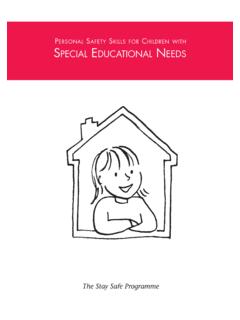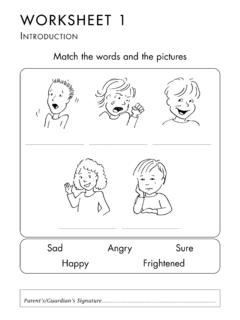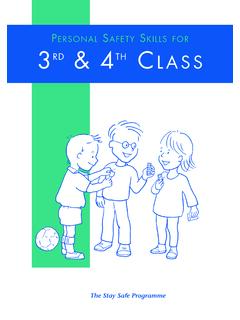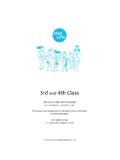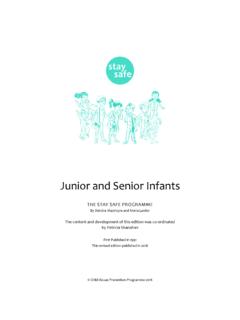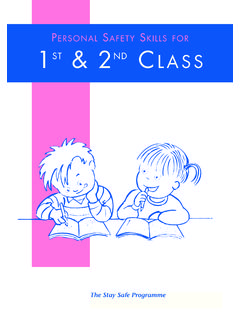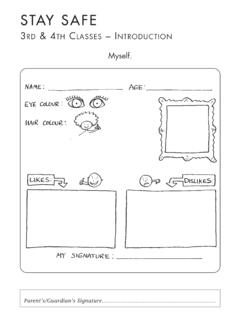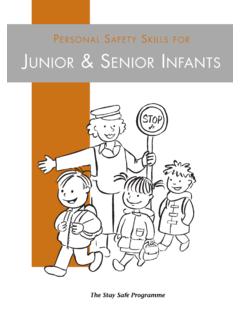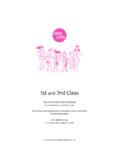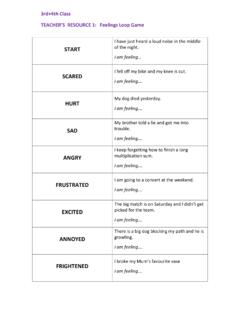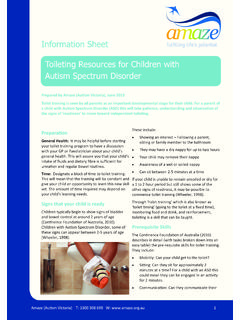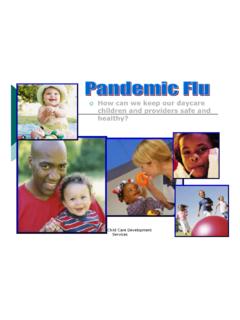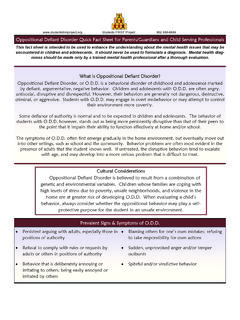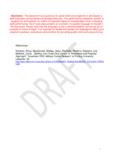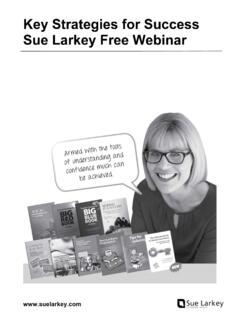Transcription of Stay Safe
1 stay safe Best Practice in Child Protection Guidance for Schools Child Abuse Prevention Programme Bridge House, Cherry Orchard Hospital, Dublin 10. Tel: 01 6206347 Email: CHILD ABUSE PREVENTION PROGRAMME. CONTENTS. Introduction.. 3. Developing a Child Protection Policy I Prevention .. 5. II Procedures .. 9. III Practice .. 13. children with Special Educational Needs .. 22. Drawing up a Child Protection Policy .. 23. Key Points Checklist .. 24. Appendix 1: Sample Child Protection Policy .. 25. Appendix 2: Sample Recording Sheet .. 28. Child Abuse Prevention Programme, Bridge House, Cherry Orchard Hospital, Child Abuse Prevention Programme Dublin 10. Tel: 01 6206347 jean langley graphic design services 087 2249752. Email: Illustration: Barbara Nolan 1. TEACHERS ARE PARTICULARLY WELL PLACED to observe and monitor children for signs of abuse.
2 They are the main care givers to children outside the family context and have regular contact with children in the school setting. Teachers have a general duty of care to ensure that arrangements are in place to protect children and young people from harm. In this regard, young people need to be facilitated to develop their self-esteem, confidence, independence of thought and the necessary skills to cope with possible threats to their personal safety both within and outside the school. Boards of Management, principals and senior management teams have primary responsibility for the care and welfare of their pupils. MANAGEMENT ARRANGEMENTS. within primary and post-primary schools should provide for the following: (i) the planning, development and implementation of an effective child protection programme;. (ii) continuous monitoring and evaluation of the effectiveness of such provision.
3 (iii) the effective implementation of agreed reporting procedures;. (iv) the planning and implementation of appropriate staff development and training programmes.. children First, Chapter 6, pp 50/51. 2. INTRODUCTION. children , because of their dependency and immaturity, are vulnerable to abuse. Child abuse may take many forms but it can be categorised into four different types: neglect, physical abuse, emotional abuse and sexual abuse. A child may be subjected to one or more forms of abuse at any given time. While parents/guardians have primary responsibility for the care and protection of their children , personnel working with children also have clear responsibilities in this area. children First': the National Guidelines for the Protection and Welfare of children , clearly outlines the significance of the role each school has to play in the prevention, reporting and handling of child abuse.
4 The development of a Child Protection Policy which addresses the role, responsibilities and practices of the school in relation to child protection is therefore advisable. The overall aim of this booklet is to assist schools in developing a comprehensive Child Protection Policy which addresses appropriate educational provision, procedures for dealing with concerns and/or disclosures of abuse and child protection practices in operation in the school. A comprehensive Child Protection Policy aims to protect children in the school while, at the same time, protecting the staff*. To that end, this booklet seeks to draw together the recommendations/guidelines currently available for schools and to add to these by giving practical advice and guidance on the development and adoption of best practice in the day-to- day organisation of school activities.
5 *The staff of the school includes all personnel (paid and voluntary) working within the school environment teachers, special needs assistants, visiting speakers/teachers, bus escorts/drivers, ancillary staff, parents helping out etc. 3. DEVELOPING A. CHILD PROTECTION POLICY. The Child Protection Policy document should specifically address the followings areas: I PREVENTION. A. Objectives B. Resources C. Formal Lessons D. Informing/Involving Parents E. Other Considerations II PROCEDURES. A. children First, National Guidelines for the Protection and Welfare of children '. B. DES Child Protection III PRACTICE. A. Recruitment and Selection of Staff B. General Conduct C. Toileting/Intimate Care D. Changing for Games E. Supervision of Pupils F. One-to-one teaching G. Visitors/Guest 4. 1 PREVENTION. SINCE THE IMPLEMENTATION of the Social Personal and Health Education (SPHE) curriculum, the school Board of Management is required to ensure that a programme of education on abuse prevention is in place in the school.
6 Curricular provision can be achieved through the full implementation of the stay safe programme as part of the school's SPHE curriculum, under the Strand unit Safety and Protection. The abuse prevention section of the school's child protection policy should include the following: A. The Objectives of the Programme The document should outline the objectives of the programme of education to prevent child abuse in use in the school to develop children 's self-esteem, assertiveness and self protective skills. to teach children that they should always tell an adult about any situation which they find unsafe, upsetting, threatening, dangerous or abusive to give children the skills necessary to enable them to recognise and resist abuse/victimisation/bullying to teach the rules . i) Say No, Get Away and Tell and ii) Never Keep Touch A Secret 5.
7 B. The Resources in use in the School stay safe Programme/An Cl r B S bh ilte stay safe pack Personal Safety Skills for children with Learning Difficulties'. C. The Formal Lessons of the stay safe Programme As part of the Child Protection Policy it is necessary to outline how the formal lessons of the stay safe programme will be taught within the context of the SPHE curriculum. Many schools find the publication Making the Links' useful in planning for SPHE. The stay safe programme should be taught in its entirety under the section Personal Safety' of the Safety and Protection strand unit. Figure 1: Making the Links, p11'. A full copy of the publication can be viewed or downloaded from the stay safe website PERSONAL SAFETY. THE stay safe . PROGRAMME. 6. D. Informing and Involving Parents/Guardians MOST PARENTS welcome the inclusion of a broad SPHE.
8 Curriculum in schools. Programmes like stay safe are most effective when parents/guardians are actively involved in the process. Many schools work closely with parents/guardians to ensure their active participation and involvement. PARENTS SHOULD BE. INFORMED about the school policy in relation to teaching the sensitive aspects of SPHE. Most schools address this by informing parents, on enrolment of their child, of the school's policy in relation to the teaching of the stay safe programme and other sensitive areas. Many schools include a copy of the booklet entitled stay safe A Parent's Guide' with the material sent to parents of newly enrolled children . INFORMATION MEETINGS for parents on specific aspects of the SPHE curriculum, stay safe , are organised by schools on a regular basis. It should however be noted that parents/guardians retain the right to withdraw their child from the sensitive aspects of SPHE.
9 7. E. Other Considerations The following may also need to be considered under this section: Teaching the programme in a multi-cultural/multi-lingual situation issues around informing parents and ensuring the messages of the programme are clearly understood by all Extra provision for children with special educational needs Teaching the programme in a multi-class situation The role of ancillary teaching staff in relation to the teaching/support of personal safety skills Education for children around the safe use of technology particularly with regard to mobile phone, internet use etc. The arrangements that will be put in place if: i) a parent wishes to withdraw his/her child from the sensitive aspects of the SPHE curriculum ii) a teacher opts out of teaching the sensitive aspects of the SPHE curriculum. 8. PROCEDURES. THE PROCEDURES that schools should follow when dealing with concerns and/or disclosures of abuse are outlined in two publications, namely: children First: National Guidelines for the Protection and Welfare of children '.
10 Department of Health and children (DOHC)). Child Protection: Guidelines and Procedures', (Department of Education and Science, (DES)). A COPY of both documents was sent to all schools in 1999. They may be downloaded from the stay safe website 9. A children First: National Guidelines for the Protection and Welfare of children '. children First' is intended to support and guide all those who come into regular contact with children in recognising and responding to possible abuse. The guidelines apply to all children not just children who are victims of abuse or neglect. Under the guidelines a child is defined as a person under the age of 18 years, excluding a person who is or has been married. B Child Protection: Guidelines and Procedures' (DES). As well as general information the following areas are specifically addressed: Chapter 1: Introduction and Legal Framework Confidentiality Protection for Persons Reporting Child Abuse Act Qualified Privilege Freedom of Information Act Chapter 2: Responsibilities of All School Personnel Designated Liaison Person How to Recognise Possible signs of Abuse Handling Disclosures from children Keeping Track of Records Chapter 3: Reporting of Concerns and Role of Health Boards Action to be taken by School Personnel Action to be taken by Designated Liaison Person Role of Health Boards Child Protection Conferences Chapter 4: Allegations or Suspicions of Child Abuse by School Employees Reporting Procedure Action to be taken by Chairperson Further follow-up required Feedback from Health Boards 10.
